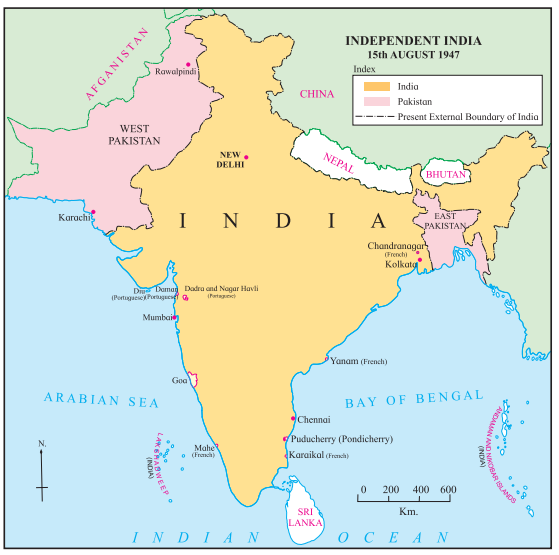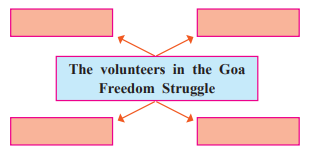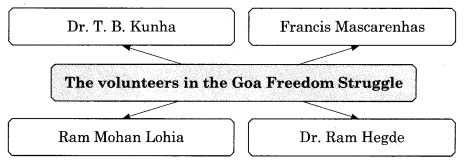Decolonisation to Political Integration of India
Exercise
Q.1 (A) Choose the correct alternative and rewrite the statement.
1. In 1946, under the leadership of Dr. Ram Manohar Lohia, the movement of ‘Civil Disobedience’ was launched in Goa.
2. Hyderabad’s struggle of freedom was led skillfully by Swami Ramanand Tirth.
3. The Princely States in India were acceded to India mainly through the efforts of Sardar Vallabhbhai Patel.
(B) Find the incorrect pair from group ‘B’, and write the corrected one.
| Group ‘A’ | Group ‘B’ |
|---|---|
| Accession of the princely state of Hyderabad | Swami Ramanand Tirth |
| Accession of the princely state of Kashmir | Shaikh Abdulla |
| Significant contribution in the ‘Goa Liberation’ Movement | Mohan Ranade |
| The trade unionist leader in Puducherry | V. Subaiyya |
Incorrect Pair: Accession of the princely state of Kashmir – Shaikh Abdulla
Corrected Pair: Accession of the princely state of Kashmir – Hari Singh
Explanation: The accession of Kashmir was facilitated by King Hari Singh, who signed the Instrument of Accession in 1947, not Shaikh Abdulla.
Q.2 Write the names of historical places/persons/events.
1. The princely state that did not accede to India immediately after its independence: Junagadh, Hyderabad, Kashmir
2. The President of Goa Congress Committee: Dr. T.B. Kunha
Q.3 Observe the map on p.no. 61 and answer the questions based on it.
1. What is the name of the country located at the northwest border of India?
Answer: Pakistan and Afghanistan.
2. Which place in India was the centre of Portuguese rule?
Answer: Goa, Dadra and Nagar haveli, Diu and Daman.
3. Which places on the eastern coast of India were the centres of French rule?
Answer: Puducherry, Karaikal, Yanam, Chandranagar
4. Which nation is located at the southern tip of India?
Answer: Sri Lanka
Q.4 Complete the following concept map.
Answer:
Q.5 Explain the following statements with reason.
1. Ultimately the princely state of Hyderabad was acceded to India.
Reason: The princely state of Hyderabad, ruled by the Nizam, initially resisted accession to India and sought to join Pakistan or remain independent. The Nizam’s suppressive policies and the atrocities committed by the Razakar organization under Kasim Razvi provoked widespread public resistance. Organizations like the Hyderabad State Congress, led by Swami Ramanand Tirth, mobilized the people, demanding merger with India. When negotiations failed, the Indian government launched “Operation Polo” on 17th September 1948, a police action that led to the Nizam’s surrender and Hyderabad’s integration into India. The strong public support and decisive government action ensured Hyderabad’s accession.
2. Puducherry was declared as a union territory.
Reason: Puducherry, along with other French colonies like Karaikal, Mahe, Yanam, and Chandranagar, remained under French control even after India’s independence in 1947. The French government was reluctant to relinquish these territories. However, public movements led by leaders like V. Subbayya and bilateral negotiations between the Indian and French governments facilitated the process of integration. A public poll in 1949–50 supported the merger of Chandranagar, and a bilateral agreement in 1954 paved the way for the merger of Puducherry and other regions. The French Parliament approved this agreement in 1962, and in 1963, Puducherry was officially declared a Union Territory of India due to its unique historical and administrative status.
Q.6 State your opinion.
1. Andhra, Karnataka, Maharashtra Councils (Parishad) were founded in the princely state of Hyderabad.
Opinion: The establishment of Andhra Parishad, Karnataka Parishad, and Maharashtra Parishad in the princely state of Hyderabad was a significant step toward mobilizing regional communities against the Nizam’s autocratic rule. These councils represented the linguistic and cultural diversity of Hyderabad, which included Telugu, Kannada, and Marathi-speaking regions. They played a crucial role in uniting people across these regions to demand civil and political rights and to push for Hyderabad’s integration into India. By fostering regional solidarity and coordinating with the Hyderabad State Congress, these councils strengthened the freedom struggle, making it more inclusive and effective. Their formation was a strategic move to counter the Nizam’s divisive policies and to align with the broader goal of Indian unity.
2. The Portuguese rule in Goa remained untouched till 1961.
Opinion: The prolonged Portuguese rule in Goa until 1961 was primarily due to the colonial power’s reluctance to relinquish control and the initial diplomatic approach adopted by the Indian government. Unlike the princely states, which were integrated soon after independence through Sardar Patel’s efforts, Goa’s liberation required a combination of public movements, armed resistance by groups like Azad Gomantak Dal, and eventual military intervention. The delay was also influenced by India’s focus on consolidating its internal political structure and the hope that diplomatic negotiations would resolve the issue. However, the strong public sentiment and the failure of negotiations prompted the Indian government to launch “Operation Vijay” in 1961, which swiftly ended 450 years of Portuguese rule. The delay until 1961 highlights the complexities of decolonization in regions under direct foreign control.




Leave a Reply